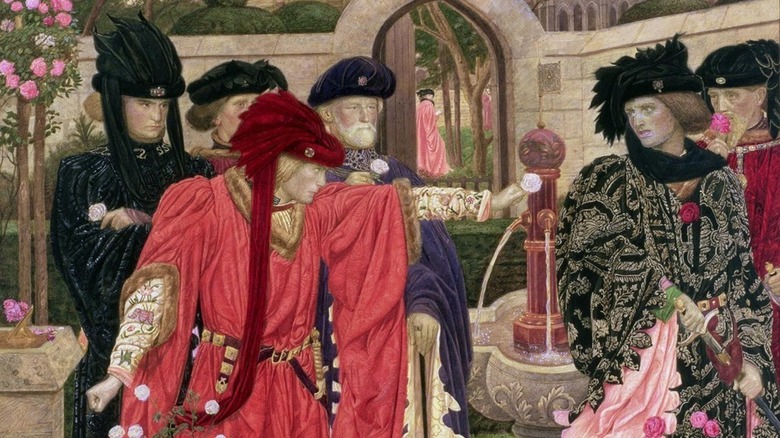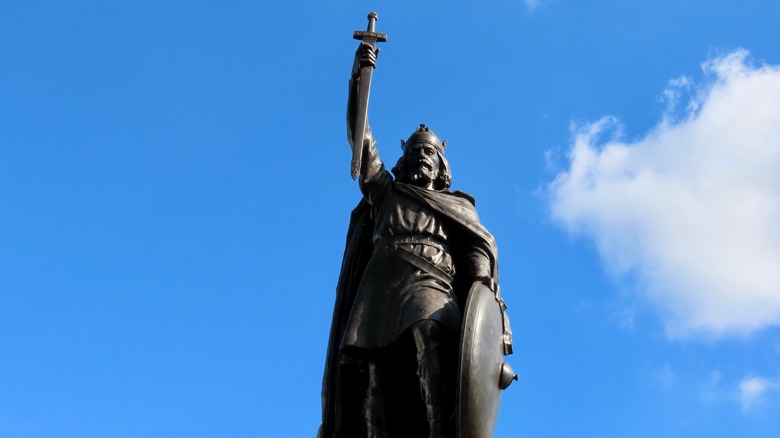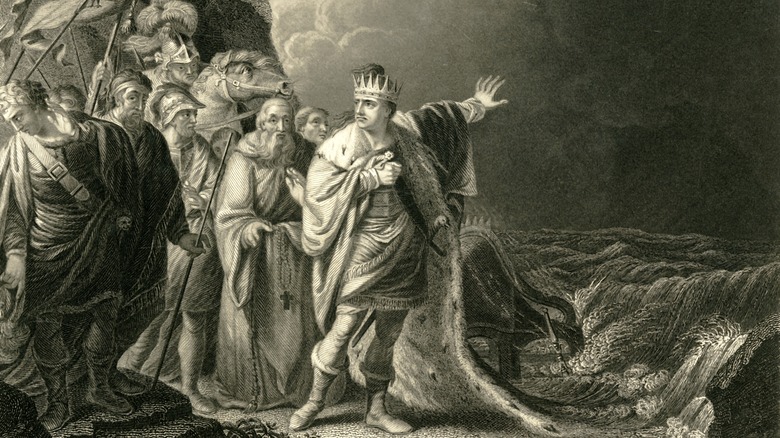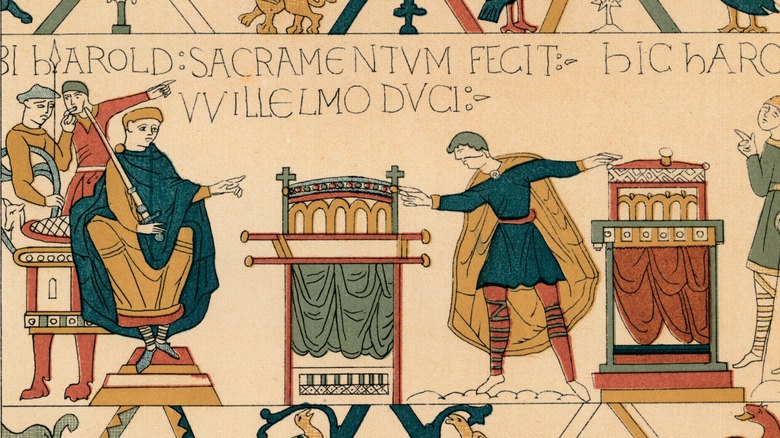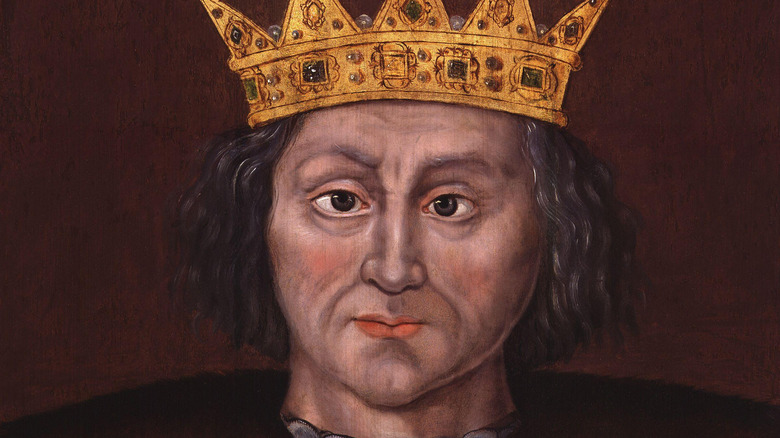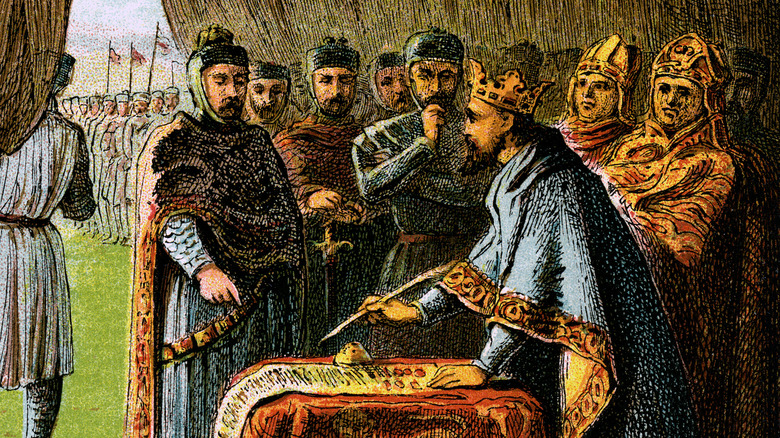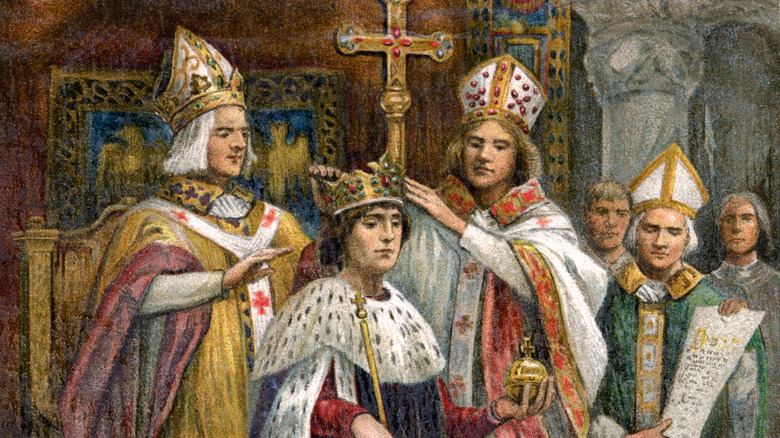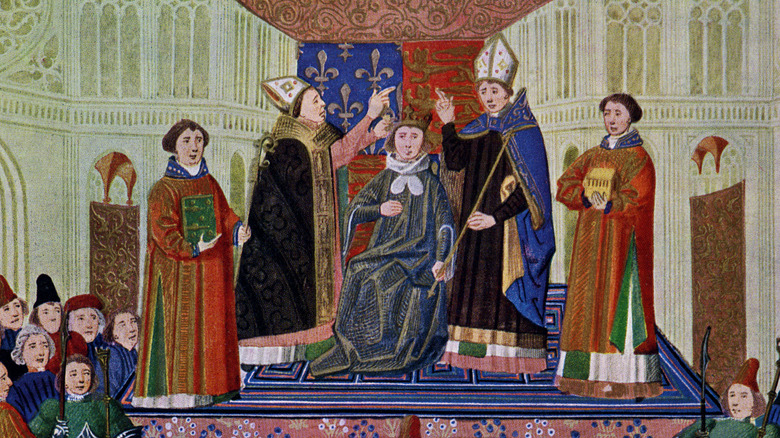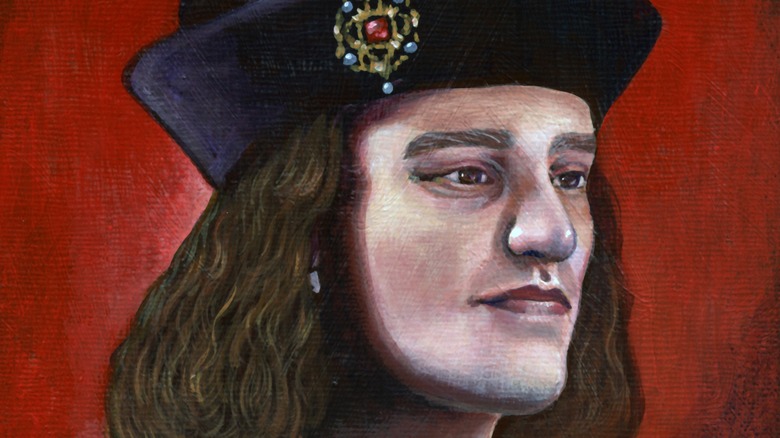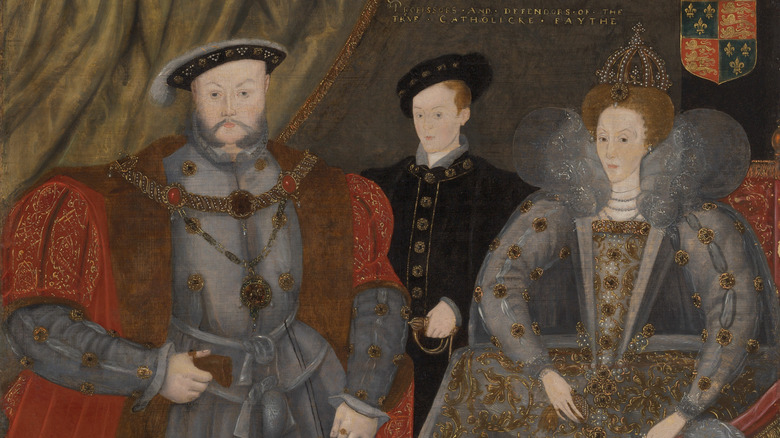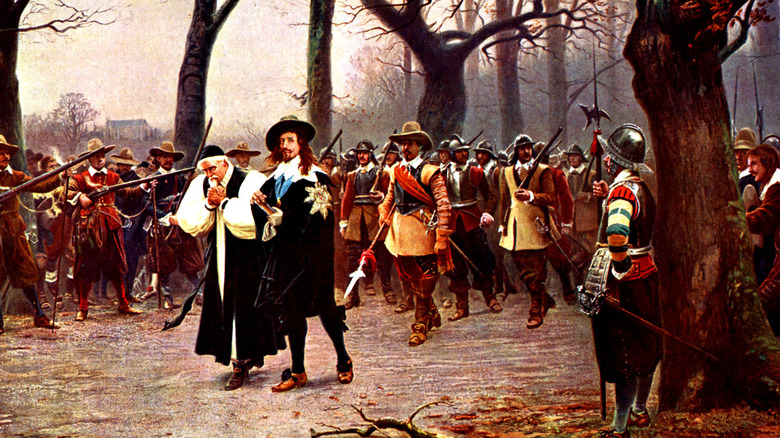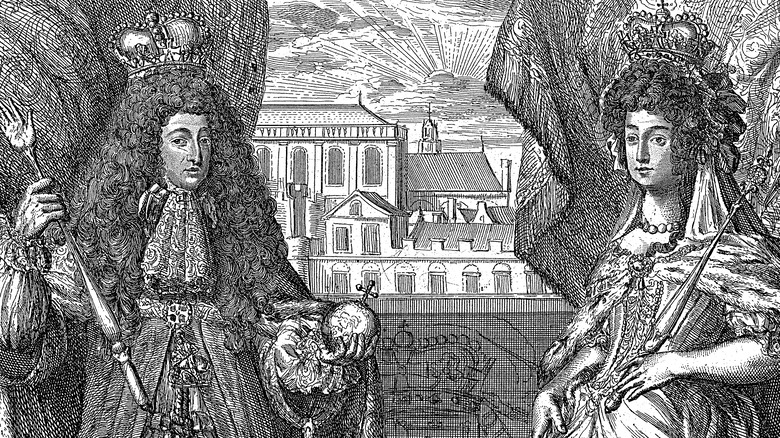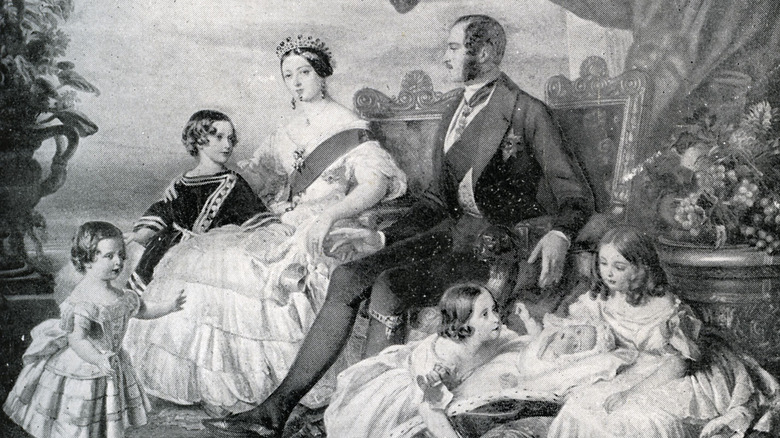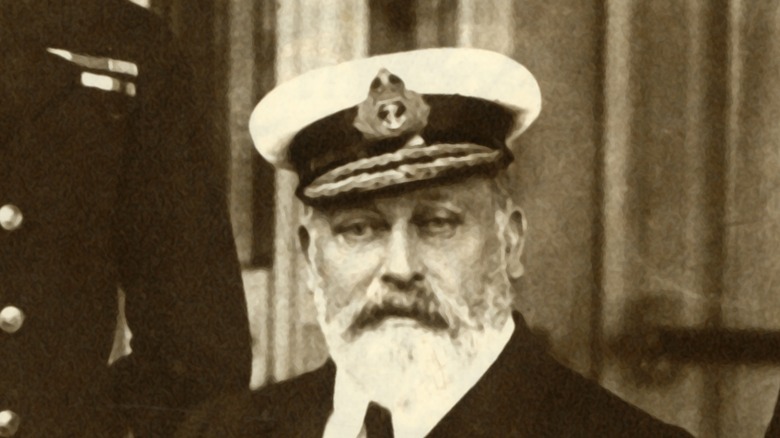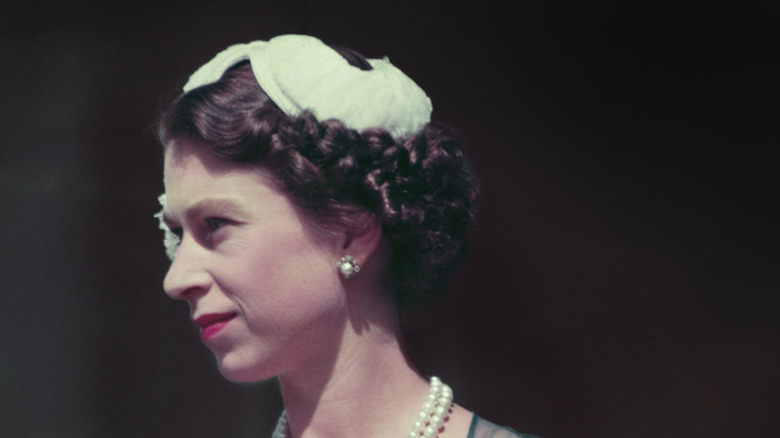British Royal Houses Explained
While the British royal houses aren't quite the Starks, Lannisters, and Targaryens, their soap operatic history has been an inspiration for "Game of Thrones." Stretching back to the Middle Ages, Britain's royal houses have been a source of fascination for millions worldwide. A royal house is the family which rules the country. These houses in Britain have changed over time. Sometimes this occurs when a female ruler bequeaths the realm to a male heir who takes on the house name of the father. Many other times the royal house changes through usurpation, murder, or political circumstance.
Britsroyal provides a handy list of each ruler of England, Scotland, and Wales from the late eighth century to the present. Counting from the earliest royal house of Wessex starting in 802, there have been 14 royal houses in British history. This accounts for only the royal houses of England and then later with its eventual unification with Wales, then Scotland. Yet, despite the numerous houses, they are almost all related. Life Magazine traced the lineage of the late Queen Elizabeth II and shows that she was a direct descendant of not only William the Conqueror but also the ninth-century Saxon king, Alfred the Great.
To keep it less confusing, the separate houses of Scotland and Wales when they were independent kingdoms will be omitted from this article, which will provide an overview of the sweeping history of the British royal houses.
House of Wessex
Wessex was properly a kingdom in what is today western England, its name derived from the Kingdom of the West Saxons. According to the World History Encyclopedia, the kingdom was created by the Saxon chieftain Cerdic in the early 6th century. Wessex was often at war with the neighboring realm of Mercia, but in the 9th century King Egbert conquered it, stylizing himself as the "Ruler of Britain." This was the start of the formation of England which was furthered by Wessex kings such as Alfred the Great, who is credited with beating back Norse invasions and introducing wide ranging reforms that helped to unify the kingdom.
The full union between Mercia and Wessex came with the ascent of Aethelstan, who became King of the Anglo-Saxons in 927. From there, Aethelstan, according to Britannica, began a policy of expansion and took land along his borders such as the Norse kingdom of York. Boundaries were established and England was created. Aethelstan was its first king. However, there was trouble on the horizon in the form of the Danes.
House of Denmark
By the 11th century, the Kingdom of England came increasingly under attack by the Danes. The British Library tells us that the kingdom increasingly paid ransom to stave off depredations. However, this only seemed to embolden the Danes, since in 1014 Swein Forkbeard removed the Wessex king Æthelred from power. Then Swein's son, Cnut (also spelled Canute), defeated King Edmund Ironside at the Battle of Assandun in 1016, which divided the kingdom. According to Britannica, Edmund's death shortly thereafter resulted in Cnut taking the whole of the kingdom for himself.
A new dynasty, the House of Denmark, was founded which consisted of England, Norway, and Denmark. To make things a bit more legit — and to prevent any usurpations — Cnut married Æthelred's widow in 1017. He also passed out English estates to his Danish followers and murdered potential Wessex claimants to the throne. After the initial shocks, Cnut calmed down a bit and tried to rule like a proper English monarch. He proved pretty effective although, as the BBC relates, Cnut is mostly known today for a moral fable of how he showed how feeble the power of a king was compared to God when he could not prevent the tide from coming in. Cnut died in 1035, but his sons were so ineffectual and feuded so much that the Wessex rulers returned in 1042.
House of Normandy
The House of Wessex must have been thrilled with their comeback. However, instead of a new golden age for Wessex, disaster came from across the English Channel. The World History Encyclopedia relates how William the Duke of Normandy — who was distantly related to the House of Wessex — claimed the English throne. On October 14, 1066, he defeated King Harold II at the Battle of Hastings. On Christmas Day of that year, William was crowned King William of England and is known to history as William the Conqueror.
The House of Normandy had a lasting impact on British society from the influence of the French language to the wholesale overturning of the Anglo-Saxon elite class. But the rule of the royal house was brief. According to Britannica, William was succeeded in turn by his sons, William II and Henry I. Henry in particular was a capable monarch who designated his daughter, Matilda, as heir after his older son Henry died in 1120.
Matilda had been married to Emperor Henry V of the Holy Roman Empire when he died. She subsequently married the Count of Anjou, Geoffrey Plantagenet. Upon being made heir there was controversy. A female heir was unprecedented in both England and Normandy. It was unpopular amongst the barons despite Henry forcing his nobles to pay homage to her. Thus, upon Henry's death in 1135, his nephew Stephen, who was the son of William the Conqueror's daughter Adela, seized the throne.
House of Blois
If you were going to pick any historical royal house of Britain to be a part of, you'd probably want to avoid the House of Blois. There was only one king from this house, that being Stephen who usurped the throne from Matilda in 1135. Stephen was the son of Adela (daughter of William the Conqueror) and Stephen Henry the Count of Blois. As explained by the World History Encyclopedia, Stephen, as King of England, had a disastrous reign.
Civil war spread throughout the kingdom as supporters of Matilda vied against Stephen. At one point, Matilda was captured and held, but upon being freed set up a rival court. As for Stephen, he could not contain the chaos of the period which was dubbed "The Anarchy." Local barons began asserting their power by building castles and minting their own coinage. In the meantime, Matilda turned to backing her own son, Henry, to be the next in line for the throne. Henry even launched an invasion of England from Normandy, but he didn't have enough funds to complete a new conquest.
Stephen was predeceased by his son and only potential heir, Eustace, in 1153. With Henry threatening to invade again, Stephen signed a treaty with him agreeing to make Henry heir. When Stephen died the following year, Henry was crowned as King Henry II. It is telling that there has been no other king of Britain named Stephen.
House of Angevin
The ascension of Henry II began a long period of rule by the descendents of Matilda and Geoffrey Plantagenet. The name Plantagenet (as per the World History Encyclopedia) seems to come from the planta genista plant which was used in Geoffrey's coat of arms. The entire house is usually just called the Plantagenets, but there are several divisions among them since, through the passing of the centuries, different branches of the house formed their own houses and vied with one another.
The Angevin branch of the Plantagenet started with Henry II who started his reign in 1154. The name Angevin is related to Anjou — Geoffrey's land as a count. The territories which incorporated large portions of France as well as England have been dubbed the Angevin Empire. The Angevins featured some of the best-known personas of the medieval period including, according to Britannica, Eleanor of Aquitaine and her son Richard the Lionheart.
The Angevins did not last long. John I, who reigned from 1199 to 1216, lost significant lands in France to Philip II and then was forced to sign concessions to his barons in the famous Magna Carta. John decided to ignore the terms of the Magna Carta, and the barons broke out in rebellion. He even lost some of the Crown Jewels in a river while in flight. He died in 1216. Britain has never had a King John II.
House of Plantagenet
Even though Henry III was the son of King John and ascended successfully to the English throne in 1216, he is usually not considered an Angevin monarch but rather a Plantagenet. This may be because, as Historic U.K. mentions, so much territory had been lost under John that it was no longer the same political entity.
There were five Plantagenet kings from 1216 to 1399. This long period saw the English kings turning their attention to their British neighbors. The World History Encyclopedia explains, for example, that Edward I (reigned 1272 to 1307) conquered Wales and incorporated it into his kingdom. It is at this time, according to Royals.uk, that Edward named his eldest son and heir the Prince of Wales. This has become a venerable royal tradition. Edward also attacked Scotland but was much less successful. He was also the British king during the rebellion of William Wallace.
This line of the Plantagenets came to an end with the reign of Richard II (ruled 1377 to 1399). Apparently Richard thought himself divinely appointed which didn't play well at court. Political intrigue saw his overthrow by his cousin, Henry Bolingbroke, the Duke of Lancaster. Richard was killed while in prison in Yorkshire, then his body was put on display at the Tower of London. He was 33.
House of Lancaster
Henry Bolingbroke was the Duke of Lancaster, and it is from this that the royal house was named. Britannica tells us that Bolingbroke made his claim on the throne based on his descent from Henry III and was crowned Henry IV. He faced numerous rebellions and foreign conflicts. This forced him into conflict with Parliament from whom he needed to raise money.
The most famous of the Lancasterian rulers was Henry IV's son, Henry V (reigned 1413-1422). The World History Encyclopedia explains that much of Henry V's fame came from his victory over French forces at the Battle of Agincourt during the Hundred Years' War, which resulted in the British reclaiming much of their lost territories in France. His reign as a fighting monarch was immortalized in Shakespeare's play of the same name.
Sadly, Henry died young, probably of dysentery. His son, Henry VI, was not as effective. Suffering from bouts of insanity, he poorly reigned the kingdom from 1422 to 1461 as well as losing most of the retaken territories on the continent back to France. This helped set off the Wars of the Roses in which another branch of the Plantagenets led by the Duke of York went to war against the Lancasters. Henry VI lost the throne in 1461 to the Yorkists, and after a brief restoration from 1470 to 1471, was permanently removed and murdered in the Tower of London.
House of York
The House of York is another branch of the Plantagenets which, starting with Edward IV in 1461, successfully took the throne. There were two more Yorkist kings after Edward IV, who are listed by Britannica as Edward V and Richard III.
Edward V was barely a teenager when he ascended to the throne in 1483, so within a matter of months, the World History Encyclopedia tells us he was shunted aside by their uncle, Edward V's brother, who took the regnal name Richard III. To ensure that his nephew would pose no threat to his usurpation, it is believed he had Edward V and his younger brother (another Richard) murdered in the Tower of London. Edward V was incidentally the 13th of the Plantagenet kings.
Richard III wasn't accruing any good karma. The Lancasterians came back led by a distant cousin, Henry Tudor, who was of illegitimate descent from Edward III. Despite the shaky claim, Richard had earned a lot of enemies. After further soap operatics which entailed a possible poisoning of his own queen so that he could remarry his niece so as to prevent Henry from doing so, matters came to a boil. Henry landed with an army of French mercenaries. At the Battle of Bosworth Field in 1485, Richard was deserted by key allies and killed. The Wars of the Roses was finally over. Richard would go down in history as one of Britain's biggest villains.
House of Tudor
Henry Tudor took the throne in 1485 as Henry VII and married Elizabeth of York who, as explained by the World History Encyclopedia, was the daughter of Edward IV. This marriage was to unite the Yorks with the Lancasters.
Henry VII was a good administrator who restored the kingdom's finances. This set the stage for his famous successors, notably his son Henry VIII and Henry VIII's daughter, Elizabeth I. The House of Tudor, according to Royal.uk, ruled for 118 years. This was a great time of change for Britain. Henry VIII, aside from his numerous wives, oversaw the break from the Roman Catholic Church and the establishment of the Church of England. The struggle between Protestants and Catholics within the realm would carry on for the next century.
Elizabeth I is one of Britain's most celebrated monarchs who remarkably managed the growing country at a time when men dominated all forms of politics. Perhaps this was because she rejected marrying, knowing it would disempower her. She was nicknamed the "Virgin Queen" as a result. She encouraged overseas expansion and Shakespeare wrote his works during her reign. She would die in 1603 after a successful reign of 44 years. However, she had no heirs so with her, the House of Tudor vanished.
House of Stuart
James VI, the King of Scotland, was Elizabeth I's cousin and closest relative. As a result, he took the throne in 1603 as James I. His surname was probably originally spelled Stewart, but at some point, according to Britannica, this changed to Stuart.
The Stuarts united the thrones of England, Scotland, Wales, and Ireland for the first time. The World History Encyclopedia tells us that James I styled himself as the King of Great Britain. The early Stuarts in general created a problem because they firmly believed in their divine right to rule. This placed them into conflict with Parliament, which came to a head during the English Civil Wars (1642 to 1651). This period saw the overthrow and execution of James' son Charles I by Parliamentary forces and the establishment of a Protectorate led by Oliver Cromwell. However, the strict, religiously driven rule of the Protectorate led to its dissolution after Cromwell's death in 1660. Charles's son, Charles II, then took the throne in a restoration of the Stuarts.
Charles II was tolerated, but when his brother James II took the throne in 1685, he alienated and maddened people over religion (James II was a practicing Catholic). When his son was born and baptized a Catholic it was the last straw. He was removed by Parliament in 1689 who invited his daughter, Mary II, to take the throne in what was called the Glorious Revolution.
House of Orange
Mary II was married to William of Orange of the Netherlands. Britannica explains that he co-ruled with Mary until her premature death of smallpox at age 32 in 1694. William would continue to rule until 1702 as a sole ruler. The religious matter was settled and the Crown, according to Royal.uk, became a defender of Protestantism. In fact, in 1701 Parliament declared that only Protestants could hold the throne under the Act of Settlement.
William III has been credited with exhibiting monarchial restraint and in doing so did much to preserve the monarchy after the destructive civil wars. While he was disliked by elites for his foreignness, he was nevertheless admired and appreciated by the other classes.
William and Mary had no children. The crown passed to Mary's sister Anne. Queen Anne had no children either, so when she died in 1714 the Stuart lineage truly ended. The crown passed to her nearest Protestant relative by terms of the law. This bypassed the son of James II and fell to George the Elector of Hanover in today's Germany. George was the great-grandson of James I and well away from being in line for the throne.
House of Hanover
George I was the first of the Hanoverian kings. This royal house had remarkable longevity. Royal.uk states that they remained in power from 1714 to 1901 during a long period of stability, prosperity, and the finalization of the constitutional monarchy. During their time, the underlying structure of British politics and government to this day was created.
Curiously, despite nearly two centuries of Hanoverian rule, there were only six monarchs of this house. This was because the reigns of these monarchs were longer. History tells us that George III, for example, reigned from 1760 to 1820 making him the longest reigning king in British history. Unfortunately, George III suffered violent episodes of insanity during his reign. His granddaughter, Victoria, reigned even longer, from 1837 to 1901, according to Britannica.
These monarchs witnessed a period of tremendous change in Britain, particularly seeing its industrialization and the expansion of the British Empire to its zenith. To give an idea of how Britain's imperial ambitions had truly become global during the Hanoverians, Victoria was named Empress of India in 1876. The reign of Victoria was so synonymous with the times that her name became the name of the era in which she ruled.
House of Saxe-Coburg-Gotha
Victoria married her first cousin, Prince Albert of Saxe-Coburg-Gotha in 1840. Despite being disquieted by children and despising pregnancy, Britannica tells us that Victoria and Albert had nine kids.From these children many of the royal houses throughout Europe were descended. For example, at one point, the German Kaiser, the British King, and the Russian Tsar all were the grandchildren of Queen Victoria.
When Victoria died in 1901, her eldest son became King Edward VII. The royal house, therefore, changed to his father's house name, Saxe-Coburg-Gotha. After the breakout of World War I, all the royal cousins went to war with one another. By then, Edward's son George V was king. In the anti-German atmosphere of the time, History tells us that the royal family grew sensitive about its German roots. King George proclaimed on July 17, 1917, that all male descendants of Queen Victoria who were British subjects would be surnamed Windsor after the castle of the same name. Interestingly, according to Royal.uk, until this time, royal families did not have surnames although they could belong to a house.
House of Windsor
That brings us to the House of Windsor. One caveat on the name: Royal.uk describes how in 1960, Queen Elizabeth II and her husband Duke Philip, the Duke of Edinburgh, said that all male Windsors and unmarried Windsors who were not styled as Royal Highness or have the title of Prince or Princess would have the name Mountbatten-Windsor, which reflects Philip's surname.
George V (our first Windsor) died in 1936. He was succeeded by his son Edward VIII. However, as related by Brittanica, Edward abdicated the throne that year in a scandal that involved him running off to marry the American Wallis Warfield Simpson. His younger brother, therefore, became George VI. George, a stutterer, became the subject of the inspirational 2010 film, "The King's Speech."
George VI died in 1952 and was succeeded by Elizabeth II. Elizabeth, who died in 2022, had the longest reign of any monarch in British history. She saw the dismantling of the British Empire and the great changes of the 20th and early 21st century. As monarch, her power was ceremonial but she did much to try to keep the image of royal family as an ideal, which at times was challenged by various scandals, not least her relationship with her son's first wife, Princess Diana. Still, Queen Elizabeth's role in connecting the past history and duty of the royal houses to the present has made British royalty a cherished institution, even in a time well away from Swein Forkbeard.
